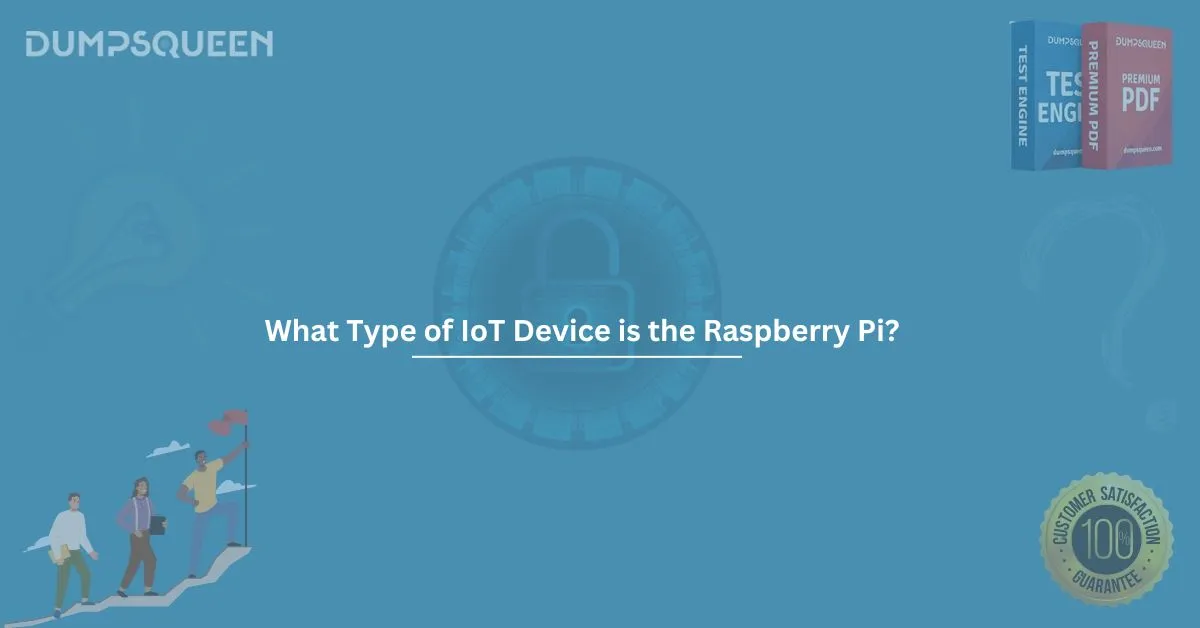In today’s fast-evolving world of technology, the Internet of Things (IoT) has become the backbone of innovation in industries ranging from healthcare to manufacturing. Among the many devices that have enabled this transformation, the Raspberry Pi stands out as one of the most versatile and cost-effective tools for IoT development. But what type of IoT device is the Raspberry Pi exactly?
This guide from DumpsQueen Official breaks down everything you need to know—from classification and capabilities to real-world applications and technical specifications.
Understanding the IoT Ecosystem
Before we answer the core question, it's important to understand what an IoT ecosystem looks like. In any typical IoT system, there are four major components:
- Sensors/Devices – Collect data from the environment.
- Connectivity – Connect sensors/devices to a cloud or central hub.
- Data Processing – Analyze data to generate actionable insights.
- User Interface – Allows human interaction with the system.
Devices in the IoT ecosystem can generally be classified as:
- Sensor Nodes
- Actuator Devices
- Edge Devices
- Gateways
- Controllers
- Embedded Systems
- Development Boards
So, where does the Raspberry Pi fall in this structure?
What Type of IoT Device is the Raspberry Pi?
The Raspberry Pi is best classified as an Edge Device and Development Board. Here's why:
1. Edge Device Functionality
Edge devices are responsible for collecting data, processing it locally (at the edge), and sending relevant data to the cloud or central systems. Raspberry Pi fits this definition perfectly. It has the power of a full-fledged computer but comes in a compact size and cost-effective format. This allows it to:
- Run lightweight data processing applications
- Perform edge analytics
- Host local databases and web servers
- Execute machine learning models
- Interface directly with sensors and actuators via GPIO pins
2. Development Board Capabilities
Raspberry Pi also acts as a development board for IoT projects. This means it is widely used in prototyping and building new IoT systems. Developers and engineers use it to test sensors, connect wireless modules like Wi-Fi or Bluetooth, and write custom code using Python, C++, or Node.js. It offers:
- GPIO (General Purpose Input/Output) support
- USB and HDMI ports
- Ethernet and Wi-Fi capabilities
- Camera and audio inputs
- OS support (Linux-based, like Raspbian)
This makes the Raspberry Pi an ideal device for learning, testing, and deploying IoT solutions.
Why Raspberry Pi is Popular in IoT?
There are several reasons why Raspberry Pi is one of the most preferred tools in IoT development:
1. Affordability
One of the main attractions of the Raspberry Pi is its low cost. You can set up a functioning IoT edge device with minimal investment, making it ideal for both students and startups.
2. Flexibility
It supports a wide range of sensors, communication modules (Bluetooth, Zigbee, LoRa), and programming languages, giving developers maximum freedom in how they build their systems.
3. Community Support
With millions of users and a massive developer community, there's no shortage of tutorials, libraries, and sample code available for Raspberry Pi-based IoT projects.
4. Educational Value
From school projects to university-level research, Raspberry Pi is a staple for hands-on education in electronics, embedded systems, and computer science.
Common Raspberry Pi IoT Use Cases
The practical applications of Raspberry Pi in IoT are vast. Here are some of the most common ones:
1. Home Automation
- Smart lighting systems
- Voice-activated assistants
- Security cameras with motion detection
- Smart thermostats
2. Industrial Monitoring
- Machine vibration monitoring
- Temperature and humidity control
- Asset tracking
- Predictive maintenance
3. Agriculture
- Soil moisture sensors
- Automated irrigation systems
- Weather monitoring stations
4. Healthcare
- Remote patient monitoring
- Wearable medical devices (when connected)
- Medication reminder systems
Raspberry Pi vs. Microcontrollers in IoT
Many people confuse Raspberry Pi with microcontrollers like Arduino. While both can be used in IoT, they serve different roles.
|
Feature |
Raspberry Pi |
Arduino (Typical Microcontroller) |
|
Operating System |
Yes (Linux-based) |
No |
|
Multitasking |
Yes |
No |
|
Processing Power |
Higher (1.5 GHz+) |
Lower (16–48 MHz) |
|
Memory |
Hundreds of MB to GB |
Typically <256 KB |
|
Use Case |
Edge computing, full apps |
Sensor control, small logic |
If your project needs complex data analysis, real-time image processing, or AI models, Raspberry Pi is the go-to device.
Setting Up Raspberry Pi for IoT Projects
Here’s a brief guide to get started with Raspberry Pi in IoT:
- Choose a Model: Raspberry Pi 3B+, 4, and Raspberry Pi Zero W are commonly used for IoT.
- Install OS: Use Raspberry Pi Imager to flash Raspbian or Raspberry Pi OS onto an SD card.
- Connect Sensors: Use GPIO pins to connect sensors like DHT11, PIR, or ultrasonic modules.
- Enable Connectivity: Use Wi-Fi, Ethernet, or even GSM modules for network access.
- Write Code: Python is the most used language, but Node.js or Java can also be used.
- Deploy: Monitor sensor data, send alerts, and control actuators using your custom code.
Pros and Cons of Raspberry Pi in IoT
Pros
- Affordable and accessible
- Strong community and documentation
- Powerful for its size
- USB and HDMI support
- Easy to integrate with sensors
Cons
- Not real-time (due to Linux OS)
- Overkill for simple tasks (use microcontrollers instead)
- Limited I/O pins compared to microcontrollers
- Needs a power source and SD card for storage
Advanced Capabilities with Raspberry Pi in IoT
- AI at the Edge: Deploy lightweight machine learning models using TensorFlow Lite or OpenCV.
- Cloud Integration: Connect to AWS IoT, Azure IoT Hub, or Google Cloud IoT for remote monitoring and management.
- Security Features: Implement SSL/TLS, VPNs, and authentication to secure your IoT network.
- Docker and Kubernetes: Run containerized applications for better scalability.
Final Thoughts
So, what type of IoT device is the Raspberry Pi? It is primarily an edge computing device and development board—powerful enough to collect, process, and transmit data from the physical world to the digital realm. Its versatility makes it suitable for beginners, hobbyists, professionals, and researchers alike.
Whether you're building a smart home, monitoring crops, or developing a healthcare solution, Raspberry Pi is the right tool to bring your IoT project to life.
Sample MCQ Questions and Answers
Q1. What type of IoT device is the Raspberry Pi most accurately classified as?
A) Sensor Node
B) Gateway Device
C) Edge Device
D) Actuator
Answer: C) Edge Device
Q2. Which feature distinguishes Raspberry Pi from a typical microcontroller like Arduino?
A) Supports analog pins
B) Lacks operating system
C) Multitasking capabilities
D) Used only for prototyping
Answer: C) Multitasking capabilities
Q3. Which operating system is commonly used on Raspberry Pi for IoT projects?
A) Windows IoT
B) Android
C) MacOS
D) Raspbian (Raspberry Pi OS)
Answer: D) Raspbian (Raspberry Pi OS)
Q4. Which of the following is a valid use case for Raspberry Pi in IoT?
A) Desktop video editing
B) Soil moisture monitoring
C) Enterprise-grade cloud computing
D) Cryptocurrency mining
Answer: B) Soil moisture monitoring




